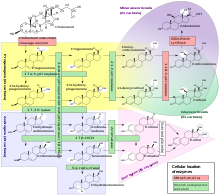11-Deoxycortisol
The absence of this enzyme in sea lampreys indicates the existence of a complex and highly specific corticosteroid signaling pathway that emerged at least 500 million years ago with the advent of early vertebrates.It's important to note that these mechanisms may be relevant not only for cortisol-induced hypertension but also for conditions such as Cushing's syndrome (excess cortisol production), apparent mineralocorticoid excess (related to defects in 11β-hydroxylase enzymes), licorice abuse (glycyrrhetinic acid affecting glycyrrhetinic acid receptor),[18] chronic renal failure (prolonged half-life of cortisol due to reduced 11β-hydroxylase activity), and even essential hypertension where there may be abnormalities with 11β-hydroxylase activity or glucocorticoid receptor variations.Low cortisol levels can disrupt this system, leading to altered angiotensin production, reduced aldosterone secretion, and subsequently lower blood pressure.[24] In 1934, biochemist Tadeus Reichstein, working in Switzerland, began research on extracts from animal adrenal glands in order to isolate physiologically active compounds.[27] In 1949, American research chemist Percy Lavon Julian, in looking for ways to produce cortisone, announced the synthesis of the Compound S, from the cheap and readily available pregnenolone (synthesized from the soybean oil sterol stigmasterol).[28][29] On 5 April 1952, biochemist Durey Peterson and microbiologist Herbert Murray at Upjohn, published the first report of a breakthrough fermentation process for the microbial 11α-oxygenation of steroids (e.g. progesterone) in a single step by common molds of the order Mucorales.
IUPAC nameCAS NumberChEMBLChemSpiderECHA InfoCardIUPHAR/BPSPubChemCompTox DashboardSMILESChemical formulaMolar massMelting pointstandard stateendogenousglucocorticoidsteroid hormonemetabolic intermediatecortisolTadeusz ReichsteinSteroidogenesischolesterol17α-hydroxyprogesterone21-hydroxylase11β-hydroxylasebiological activitysea lampreysmetamorphosisseawaterCYP11B111-deoxycorticosteronecorticosterone11β-hydroxylase deficiencymineralocorticoidhypertension21-hydroxylase deficiencylow blood pressuremineralocorticoidselectrolytesCushing's syndromelicoriceglycyrrhetinic acidvascular toneandrostenedionebiochemistTadeus ReichsteinSwitzerlandadrenal glandsphysiologically activePercy Lavon JuliancortisonepregnenolonestigmasterolmicrobiologistUpjohnfermentationprogesteroneMucoralesCortexolone 17α-propionateBibcodeChicago TribuneChemical & Engineering NewsJ Am Chem SocHormonesEndocrineglandsHypothalamic–pituitaryHypothalamusDopamineSomatostatin (GHIH)Posterior pituitaryOxytocinVasopressinAnterior pituitaryProlactinEndorphinsLipotropinAdrenal axisAldosteroneDHEA-SAdrenalineNorepinephrineThyroidThyroid hormonesCalcitoninThyroid axisParathyroidGonadal axisTestisTestosteroneInhibinEstradiolActivinRelaxinPlacentaEstrogenPancreasGlucagonInsulinAmylinSomatostatinPancreatic polypeptidePineal glandMelatoninN,N-Dimethyltryptamine5-Methoxy-N,N-dimethyltryptamineThymusThymosinsThymosin α1Beta thymosinsThymopoietinThymulinDigestive systemStomachGastrinGhrelinDuodenumSecretinMotilinEnteroglucagonPeptide YYInsulin-like growth factorAdipose tissueLeptinAdiponectinResistinSkeletonOsteocalcin


